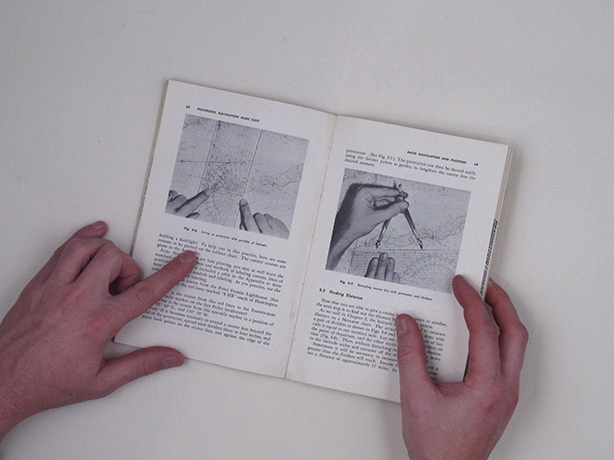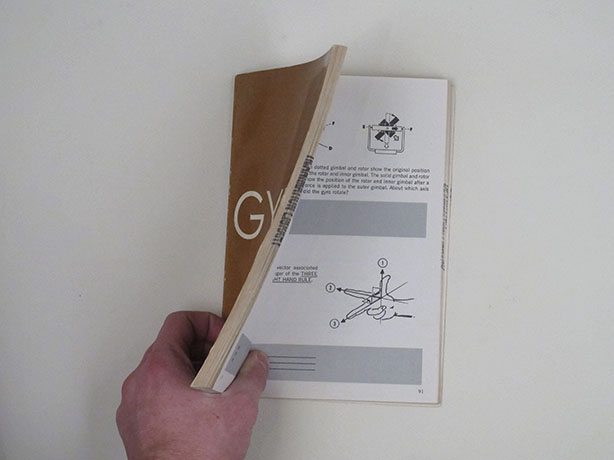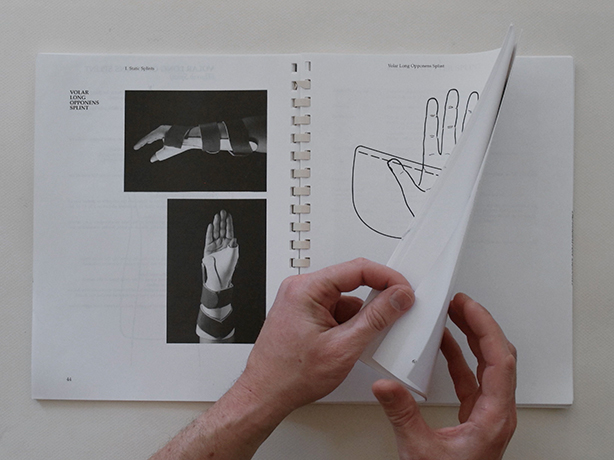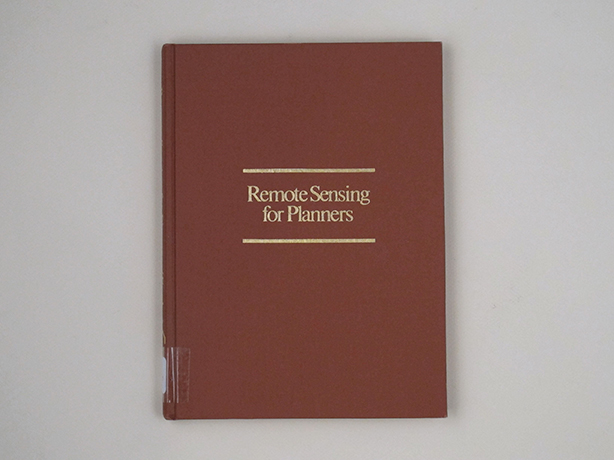WORD PROCESSOR: HIGHLIGHTS FROM THE COLLECTION
January 28, 2013
An Atlas of Misreading
Nelson Harst

If you try to solve the problems yourself, and then look up the answers, you will make some practical use of what you learn. This is the closest we, or anyone else, can come to actually showing you how to navigate.
Electronic Navigation Made Easy, John D. Lenk

In the deep discovery of the subterranean world, a shallow part would satisfie some enquiries.
Hydriotaphia, Sir Thomas Browne

Patterns should be extended distally.
Atlas of Hand Splinting

Vade liber qualis, non ausim dicere, felix
Go forth, my book, into the open day
Anatomy of Melancholy, Richard Burton
I: Locations of Misreading
When I was asked to write an essay for Word Processor I immediately agreed, having felt entirely in sympathy with the Reanimation Library since first visiting its location on Union Street just past the Gowanus Canal, shortly after helping complete a version of the experimental Bidoun Library. But I also had apprehensions. For one, I dislike writing enormously and have only rarely managed to finish anything. On the other hand, I do enjoy reading and will read nearly anything printed.
I spent six years working at the massive University Bookstore at the University of Washington in Seattle. While there, I managed to read portions of almost every book in the adult nonfiction section, at the very least the spine and possibly some text on the front and back of the book. If I did open the book itself, perhaps I would glance at the index, the table of contents, or the dedications.
For A. To my family, with love. To Richard who leant support and more during the writing of this book. For the Children. With thanks to the faculty of this institution and the generous assistance of the Foundation.
Rarely would I actually read any of these books in the responsible, intended fashion. I did not sit in a chair. I did not start from the beginning and trudge through to the end. Instead, while I was working at a practical task–namely shelving and retrieving books for customers who'd presumably be taking these books to their own chairs for proper reading–I read a little of everything but not much of anything. I read with a happily aimless indifference.
After leaving this job and moving to New York, I was missing this sort of magpie reading and began to visit the New York Public Library at 5th Avenue and 42nd Street to continue the practice. I'd search for some keywords in the catalog, and possibly filter by some arbitrary limits such as a date range or city of publication. The librarian would stuff my requests into the library's pneumatic tube system, and about fifteen minutes later the books would begin to appear.
I was happiest when the text I'd selected turned out to be a small pamphlet, often rebound into a new book containing other pamphlets of similar size. These unwitting anthologies dredged up new subjects, sending me back to the catalog for further requests.
Reading under the massive ceilings of the Rose Reading Room is to act a part in a deliberate theatre of literacy and culture. The ritual of waiting for a request to surface via dumbwaiter from the subterranean stacks into the sun drenched reading room felt the very act of unearthing obscurity to light. I never once felt bored or without purpose there though what I was doing was a sort of studied meaninglessness, a harmless, eccentric procrastination. The other readers bent over their requested books were serious, deliberate people working on at least nominatively productive projects. Or so I assume.
Soon though I was drifting away from the sunny Beaux Arts Rose Reading Room to the more foreboding SIBL—the Science, Industry and Business Library. Located in a darkly lit fluorescent basement on 188 Madison Avenue and 34th Street, SIBL has none of the high-ceilinged loftiness of the 5th Avenue building. The room's bland functionality was more corporate sepulcher than enlightenment exuberance. But the books were even more random, less digestible, farther flung into the outer spaces of obsolescence. There I read about the potential for Indonesian rubber production, the technique of asbestos mining, and the applications of hot injection molding.
SIBL, like all NYPL branches with their wifi hotspots, provides patrons with an online subscription of the Oxford English Dictionary. The OED is an expansive twenty-something volume set, made massive not just because of the number of words it defines, but also by supplementing the definitions with examples of the word's use. During one trip to SIBL, I accessed the online OED and looked up the word "obsolete." The entry demonstrated a circular use of the word from a book called Philosophical Enquiry. This vaguely titled book claims "Of things obsolete, the names become obsolete also."
The New York Public Library is currently in the process of selling off the SIBL property and (re)moving most of the collection off site to New Jersey. The library claims the books are rarely consulted; during my visits I only ever encountered one other reader requesting much anything from the closed stacks. He was there every day. Clearly mentally ill, he would peer at me with hostile suspicion while we waited for books to appear from the dumbwaiter. We were not the only readers requesting books at SIBL, but no one else seemed to be browsing the closed stacks via the catalog, unlike in the Rose where this seemed more common.
The books in the Reanimation Library cover many subjects, but I suspect that if it found itself absorbed into the NYPL system, most of the books would end up at SIBL, rather than the Humanities Library on 5th Avenue. Which is to say they'd end up buried deeper into the archive, further out of view, both in thing and name.
II: Handbook of Misreading
The Reanimation Library serves and proposes an entirely different purpose than any working research institution such as the NYPL. But what is that purpose? Its utility is far from obvious—it appears the books were obtained at random encounters with dollar bins. The entire collection appears to me a sort of curated accident, not quite a conscious creation but neither a typical assortment of second hand books.
So what to do with this weirdly hermetic library? One could read every book, each as its own dead end—an appealing and appalling idea. I'm reminded of the great 17th century synthesists such as Englishmen Sir Thomas Browne and Richard Burton. These once popular, now obscure writers appeared to have consumed and ingested everything in the libraries available to them at the time, absorbing and integrating their readings into sprawling baroque essays that combined a hodgepodge miscellany of antiquity with contemporary reports from the Orient and Americas with discredited alchemical claims and speculative theological elaborations into neoplatonic abstraction made useful in a pragmatic medical and physiological application. In reading "everything", 17th century writers accessed libraries that were not much larger than Reanimation Library. I'd like to limit my reading to as strange a library as the Reanimation and attempt the same essays.
But I do not have the time to carefully read every book here, and who would? Maybe the madman I'd seen at SIBL, but I would not invite him to the task. The best use of the Reanimation Library seems to require a lighter touch, a more casual encounter. Many of the books are attractive, surprising, and delightful, especially when compared to the more visually uniform books generally produced today. Their sturdiness is also striking; many of these books–especially the most technical and jargonistic–were built to last. And indeed, in many cases, their physical presence has often outlasted the use and utility of the their contents.
In any case, the more I focus on any particular item in this library, the more I lose interest in even the most intriguing of its books. The library recedes into a soft focus and I have merely a strange specimen of something, a pleasant outlier from the recent past, a novelty. Returning the book to the shelf widens the focus again and the mysterious, slightly sinister contradictions of the library sharpen. My misreadings attempt to elaborate and exaggerate these contradictions without specifying their source or meaning.
Because I wanted to consider the library as a whole without attending too carefully to its particulars, I chose a handful of books that addressed the subjects of navigation and topography. I did not attempt to discover every book in the library on these subjects; there may be more, I do not know. Consulting the catalog would likely settle this question, but part of my method of inquiry was not to do so. The catalog, which exists at the library's website can be accessed anywhere in the world. An online catalog implies that the catalog exists outside of the library and is not of the library itself. At least I take that assumption.
The first book that I used to navigate the library I found almost immediately upon walking in. After entering the room, I continued walking until I came to a door that led from the library into a game room neighboring but unrelated to the Reanimation Library. I avoided this exit and found myself at eye level facing a shelf of books affixed with Library of Congress call numbers that started with the letters RD. I do not know the Library of Congress classification system so am not sure why these books are grouped together. The book that catches my eye is titled Atlas of Hand Splinting. Like many technical texts, the introduction to this book carries a disclaimer:
This Atlas provides an instructional reference for the use of thermoplastic splints in the treatment of hand and upper extremity injuries. It does not teach splinting, rather it presents commonly used hand splints and explains indications of their use.
Some the the vocabulary in this disclaimer is too specific for my uses, so I ignore it. Thermoplastic. Upper extremity. Books are handy objects, a technology built to the scale of our palms and fingers. A book written as an atlas of possible hand injuries and their repair strikes me as a useful reference for navigating a nearly nonsensical library.
Though happy to have found an atlas so quickly, I suspect books at eye level may have already been stripmined of meaning by previous visitors, so I go deeper and begin to search the lower shelves.
I immediately feel at home in the section labeled VK. A field guide to missiles lands at a dead end, but a nearby book named Electronic Navigation Made Easy proves promising. The book opened to the page favored by its broken spine; a photograph of a hand holding a protractor over a map using forefinger and thumb while another hand positions a transparent plastic protractor. Below these hands and splints is a detailed nautical chart. I refer back to the Atlas of Hand Splinting, unsure how to use the map in the photograph. The Atlas helpfully explains:
During the acute healing phase of an injury or following surgery, a splint may be used continuously. As the patient improves and motion initiated, splints are used intermittently between exercise sessions. Just as the use of a splint changes, so does its function.
Immediately adjacent to Electronic Navigation Made Easy is a misshelved but related title, Gyro Fundamentals. While Electronic Navigation is intended to assist boat owners, Gyro Fundamentals is for aircraft pilots. The book explains:
We are living in an age of science and space travel. With this has come a great emphasis on the application of gyroscopes for the navigation of aircraft and space vehicles. Unfortunately, for many, it has been difficult to understand the unique concepts involved in the performance of gyroscopes.
Of course gyroscopes are not useful for navigating a library. But a book about gyroscopes might be useful for navigating this library. Not merely a book, Gyro Fundamentals is a "Programed Text" published by the John F. Rider Publishing Company. A Programed Text is a piece of paper software run not by a computer, but by a reader who is given a set of precise instructions to perform. The book works by hiding and then revealing information on the opposite side of the page being read:
Each page of this book has a top and bottom frame, and the student must follow the frames in exactly the order presented. The frames are numbered consecutively and so arranged that the first half of the text proceeds from the top frame of one right-hand page to the top frame of the next. Likewise, the second half proceeds from the bottom frame of one right-hand page to the bottom frame of the next.
The Atlas of Hand Splinting again proves a useful reference. A splint is a sort of frame, a structure to contain and reshape. Paging through the frames of Gyro Fundamentals, I find the hand again, and not just the right and left handed instructions for activating the Programed Text. Actual hands are drawn into the text. A hand is shown with thumb up, index finger extended to make a right angle while middle finger points in a perpendicular direction. This gesture allows the reader, a prospective pilot of aircraft or spacecraft, to identify precession vector with thumb representing the spin vector, index finger as torque and middle finger, precession. Thus does the hand navigate the gyroscope.
After reading these three books at the library, I lost balance. A General Electric book on lighting design added nothing to the preceding books, neither did a course on technical drawing or a dictionary of shorthand. The thin thread connecting three books ended, and inconclusively. The injured hand as tool for a plotted navigation led nowhere.
I did not return to the library for a of couple months, though I did finally browse around the online catalog. A title jumped out at me, Remote Sensing for Planners. It seemed the perfect book to not read, to not write about. At that moment, the online catalog was available, but the library itself was boxed away; the high tide full moon rising storm surge of Hurricane Sandy had threatened to lift the toxic Gowanus Canal into the building housing the library. In the end, this did not happen, though the books had been carried upstairs as a precaution. The library's temporary home on the second floor also stored a topographic sculpture made almost entirely of sulfur kitchen matches.
After the library had been carried back downstairs, unpacked and restored to its shelves, I finally got my hands on Remote Sensing and opened the book to a random page, which contained the following arbitrary fragment of text:
Generally lacking
Not as vigorous
Presence of debris
Short side
Irregular, dead end twisting streets.
Nelson Harst is a bookdealer and occasional artist. He helped create the Bidoun Library's incarnations at the New Museum and Serpentine Gallery.
View Atlas of Hand Splinting, Electronic Navigation Made Easy, Gyro Fundamentals, and Remote Sensing for Planners in the catalog.
